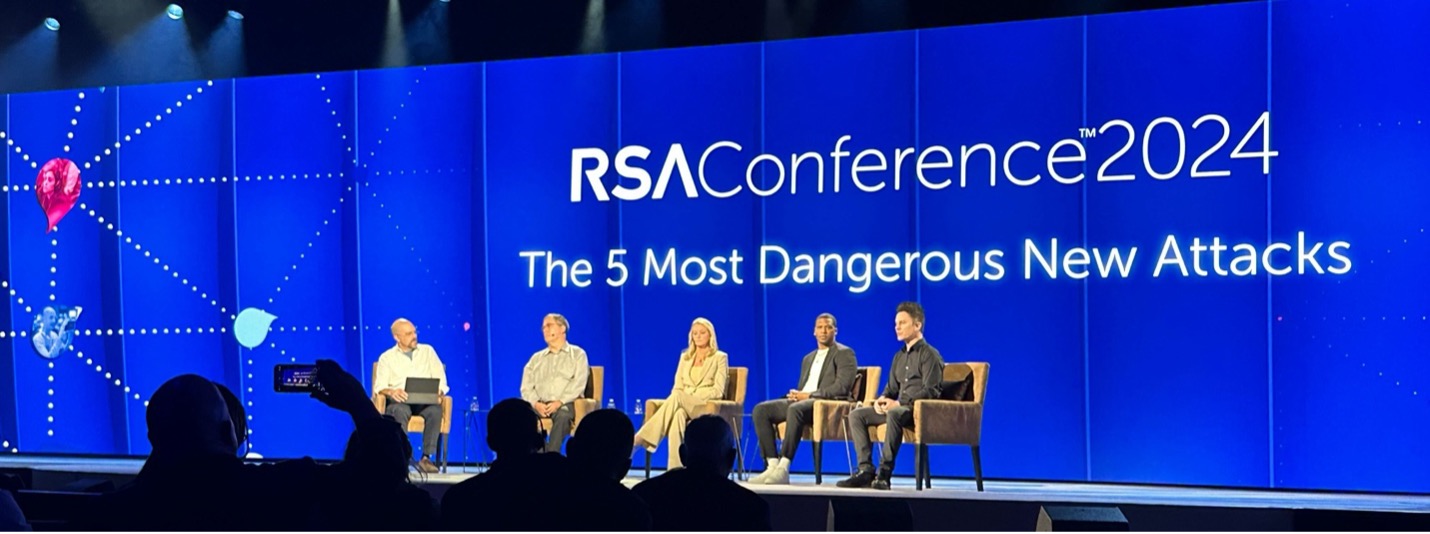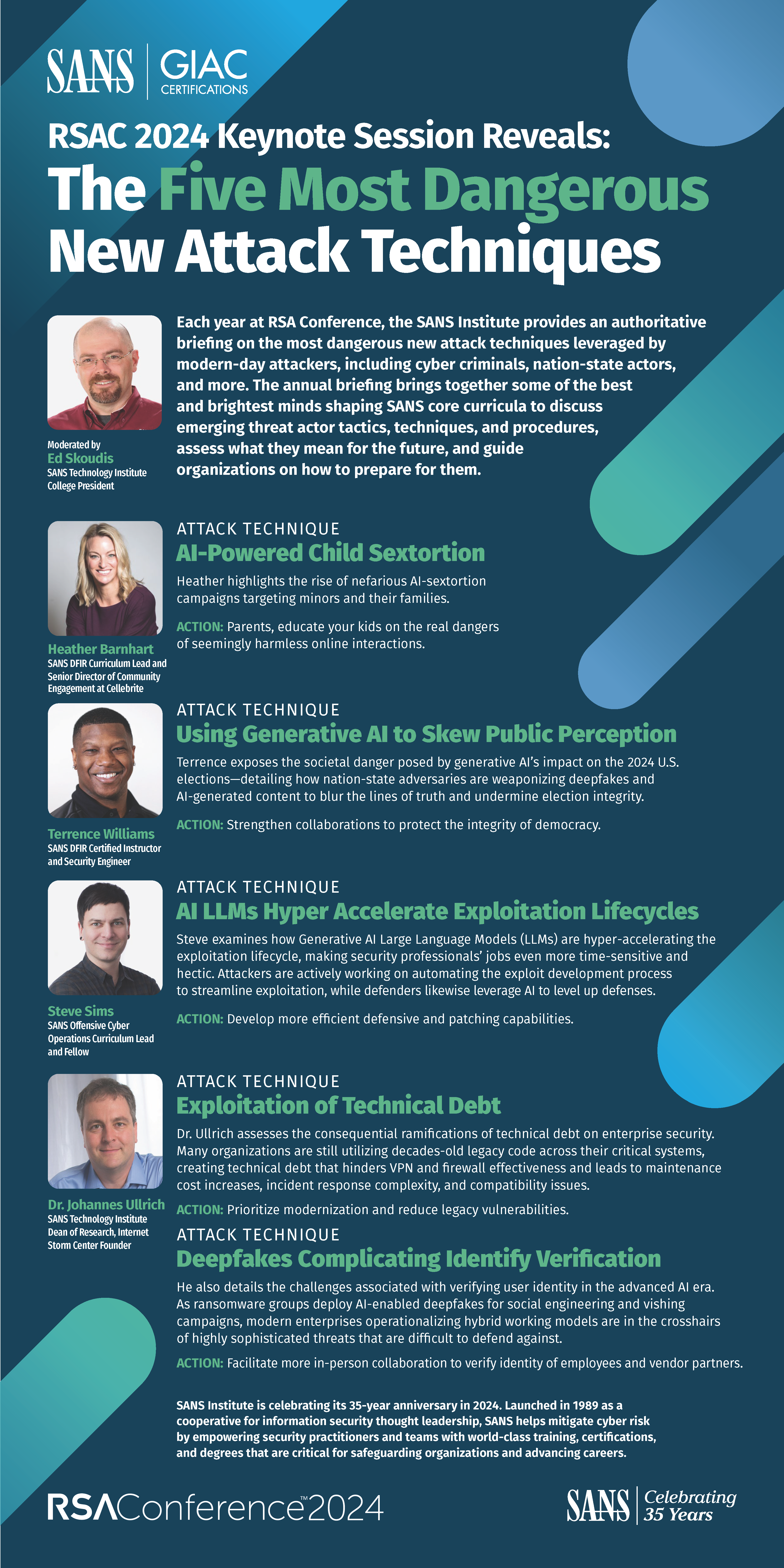SEC595: Applied Data Science and AI/Machine Learning for Cybersecurity Professionals


Experience SANS training through course previews.
Learn MoreLet us help.
Contact usBecome a member for instant access to our free resources.
Sign UpWe're here to help.
Contact UsThis year’s keynote panel spark crucial discourse on combating the emerging threats of 2024.


The RSA Conference 2024 has always been the go-to event for cutting-edge cybersecurity insights, and this year's keynote address was no exception. The esteemed panel of guests outlined the "five most dangerous new attack techniques" that every cybersecurity professional should be aware of. As we navigate these complex challenges, it's crucial to stay informed and proactive in our cybersecurity strategies.
From artificial intelligence (AI) powered sextortion and deepfakes disrupting election security to AI-accelerated exploit lifecycles and the underappreciated dangers of legacy tech risks, our panel of cybersecurity experts crafted their sessions to spark crucial discourse on combating these emerging threats.
Presented by Dr. Johannes Ullrich, SANS Technology Institute Dean of Research, Internet Storm Center (ISC) Founder.
In his presentation, Johannes highlighted one of the most overlooked vulnerabilities inherent in technical debt; outdated or poor-quality code that can jeopardize security. With the retirement of skilled developers and corporate acquisitions, maintaining and updating old systems becomes a Herculean task. Companies are advised to prioritize code review and adopt incremental upgrades to mitigate these risks. Johannes also discussed leveraging AI for code maintenance and training new developers through transcription of old code are practical steps forward.
Presented by Dr. Johannes Ullrich.
Verifying identities online has become more complicated and important in our increasingly complex digital world. To that end, Johannes detailed how traditional security tests like CAPTCHAs are no longer reliable, as AI can often outperform humans in these areas. His presentation stressed the importance of establishing robust identity verification processes that balance security with user privacy. Johannes recommends innovative approaches like risk-based identity verification using AI to flag unusual behaviors to enhance security without adding undue intrusiveness.
Presented by Heather Mahalik Barnhart, SANS DFIR Curriculum Lead, Senior Director of Community Engagement at Cellebrite.
Heather’s lecture detailed the alarming rise in AI-enabled social engineering techniques and AI-generated content to sextort teenagers. Threat actors are extorting teens by threatening to release sensitive personal information, real or not. The FBI has warned families about this “rapidly escalating threat” amid rising child suicide and sextortion training materials surfacing on TikTok, Instagram, Snapchat, and YouTube. Heather detailed awareness and preventative measures including education on digital privacy are key to combating this invasive technique.
Presented by Terrence Williams, SANS DFIR Certified Instructor and Security Engineer
In his discussion, Terrence explored the profound impact of Generative AI on democratic processes, detailing how nation-state adversaries are weaponizing deepfakes and AI-generated content to blur the lines of truth and undermine election integrity. With the power to both enhance civic engagement and fuel disinformation campaigns, the double-edged sword of AI in politics requires careful governance. The ongoing challenge is to preserve trust and integrity in elections amidst the potential for AI-enhanced misinformation and voter suppression tactics.
Presented by Stephen Sims, SANS Offensive Cyber Operations Curriculum Lead and Fellow
Stephen Sims introduced the concept of how large language models (LLMs) are revolutionizing the exploitation lifecycle in cybersecurity. From automated red teaming to adversarial AI, these technologies are making it faster and easier for both security professionals and attackers to identify vulnerabilities and develop exploits. Stephen’s keynote underscored the dual-use nature of AI in cybersecurity, necessitating a balanced approach to its deployment.

As we mark the 35th anniversary of SANS, it is clear cybersecurity is evolving more rapidly than ever before. To not only keep pace with but to stay ahead of these changes, continuous learning and adaptation are essential. That’s why it’s never been a better time than now to enroll in the new SANS Artificial Intelligence course.
Don't miss this chance to advance your career and expertise in cybersecurity. This course is designed to equip professionals with the latest AI-driven cybersecurity techniques and strategies. Register for SANS AIS247: AI Security Essentials for Business Leaders AI today and ensure you're prepared for the challenges ahead.
And if you need personalized guidance or have specific training needs, don't hesitate to speak to a training advisor. Complete the form here to get started.
If you are an RSA Conference 2024 pass holder, you can watch the full SANS keynote on demand here. If not, don’t fret. We’ll be sharing the recording when it’s available for viewing on YouTube. This is a pivotal moment for the cybersecurity community to learn, adapt, and stay ahead of the emerging threats that shape our digital world. Join us in this journey to a more secure future.



Launched in 1989 as a cooperative for information security thought leadership, it is SANS’ ongoing mission to empower cybersecurity professionals with the practical skills and knowledge they need to make our world a safer place.
Read more about SANS Institute